
Topics
Guests
- Dr. Michael Gibsonprofessor of medicine at Harvard Medical School. He is a full-time cardiologist and chief of clinical research in the Cardiovascular Division at Beth Israel Deaconess Medical Center, Harvard Medical School. He is the founder of wikidoc.org, the world’s most widely viewed open-source textbook of medicine. He was on call Monday treating victims of the bomb blasts at the Boston Marathon.
- Charles P. Piercestaff writer for Grantland and is the lead writer for Esquire.com’s politics blog. He is a frequent guest on NPR.
Doctors in Boston have reportedly carried out at least 10 amputations on bombing victims after the attack at the Boston Marathon. A trauma surgeon at Massachusetts General Hospital said many patients suffered shrapnel wounds, either from the bombs directly or from the resulting debris. We continue our coverage of the attack with two guests: Dr. Michael Gibson, a doctor at Beth Israel Deaconess Medical Center who treated bombing victims on Monday and whose son ran in the marathon, and Charles Pierce, a Boston-based reporter and lead writer for Esquire.com’s politics blog. [includes rush transcript]
Transcript
AMY GOODMAN: This is Democracy Now!, democracynow.org, The War and Peace Report. I’m Amy Goodman, with Aaron Maté.
AARON MATÉ: Well, as we continue our coverage of the Boston Marathon attack, Michael Gibson is a doctor at Beth Israel Deaconess Medical Center and professor of medicine at Harvard Medical School. He was on call Monday treating victims of the bomb blasts at the Boston Marathon. His son ran in the marathon yesterday.
We’re also joined by Charles Pierce, a Boston-based reporter and lead writer for Esquire.com’s politics blog. He wrote a piece yesterday called “The Remains of a Horrible Day in Boston.”
AMY GOODMAN: Why don’t we start with the doctor, talking about what you have seen at the Deaconess, what has happened, what you understand has taken place. Dr. Michael Gibson?
DR. MICHAEL GIBSON: Yes. Thank you, Amy.
Well, it was a bit like a war scene, essentially. You know, watching TV, seeing the show Inside Combat Rescue, where you see a lot of implemented explosive devices and loss of limb, it was eerily reminiscent of that. And people were missing lower extremities. There was, as you’ve heard reports, of a lot of shrapnel—again, not clear if that came from the bomb itself or from the container that the bomb was in or nearby debris. But most of the injuries were to the lower extremities, although shrapnel was present everywhere. A lot of people had hearing loss from the blast, as well.
We had many trauma bays obviously completely filled with patients. There were two waves. The first wave was of about eight patients that were critically injured, and then those patients went off to the operating room. And then a second wave of patients then arrived to fill those beds. So, a very, very, very dramatic, traumatic scene yesterday. But I have to say, the ER staff was very well organized. The trauma surgeons, orthopedic surgeons were spectacular. And it really was a lesson, I have to say, in organization. Sometimes too many people is not helpful, and I think a lot of it centered around getting the staff organized to get the right doctor to the right patient at the right time.
AARON MATÉ: And, Dr. Gibson, can you talk about the child victims that you saw? How many children have been treated at your hospital? And also talk about the amputations. We know that there’s been at least 10 performed so far.
DR. MICHAEL GIBSON: Yeah, so, you know, we did not have any children at our hospital that I saw. I have to say, the picture of Carlos really was cropped. And what you don’t see on the picture in most of the media is the fact that the poor young man who he was assisting had no leg. And many of these patients presented already with an amputation. There was traumatic amputations.
But I do want to emphasize, the real heroes were on the scene, people like Carlos who ran towards the blast rather than from the blast. And when they arrived at our hospital, these patients were very well stabilized. They—people like Carlos and people in the medical tents had already put on tourniquets to stop a lot of the bleeding. And that made—that may have saved many lives, people like Carlos and the people on the scene.
AMY GOODMAN: The AP, Dr. Gibson, quoted a state trooper saying a lot of people amputated: At least 25 to 30 have at least one leg missing or an ankle missing or two legs missing. Is that your sense? Is that number right?
DR. MICHAEL GIBSON: Well, I think, you know, it’s hard to know what is going to happen, because some of the people may still have a limb in place, but over time that limb may not be saved or salvaged. And that number may climb over time. There were many deformities. And it’s unclear to me how many of those limbs will be salvaged. My job was just there as a cardiac person to assess—assist with the blood flow, blood pressure, heart, the—getting access into the arteries. That was my role.
AMY GOODMAN: I know one of the big problems that the people who ran to the aid of others had are those well-known barriers, that certainly protesters face all over the country. But they were so heavy, dividing the spectators from the runners. And they were collapsing on the people, the spectators who were injured. Can you talk about the planning that—the pre-planning, the disaster scenarios that you have in Boston that may well have helped in this situation?
DR. MICHAEL GIBSON: Yeah, again, I want to emphasize, when the blast went off, you saw people pushed away by the blast, but then what was very dramatic was the wave of humanity that then rushed towards the blast. I think people put the best interest of those patients who had been injured around them first. And there was a tremendous effort to clear the area around the blast so that then emergency medical personnel could make their way into the area. You saw people pulling away the barriers. So, tremendous, heroic efforts on the part of those people, again putting the injured’s well-being ahead of theirs.
You know, at the hospitals, there were many stretchers outside the hospital. There was also a biohazard unit assembled to do kind of detoxification, if that was necessary. You know, you never know if this is just what was now being said, a black blast, which was a traditional gunpowder kind of blast, or was there any kind of contamination? And the hospital was prepared for that. The hospital was locked down both by police and by military personnel all around the hospital, so that people could not enter the hospital unless they were a patient who was injured or a caregiver with identifiable information. And then a command and control center was set up inside the emergency room, again, to triage things, to, again, get the right level of care to the right patient at the right time.
One of the things I then worked with the social workers on was connecting the family members to patients. One of the issues that happened was my son called at 2:54 to let me know that he was OK, and that was really, for me, a very, very strong emotion to let me know that we also need to let other family members know that patients are here or let them identify is their family member OK.
AMY GOODMAN: Are you also looking for evidence in the hospital? I mean, for example, the kind of shrapnel and looking for evidence of what the bombs were?
DR. MICHAEL GIBSON: Yeah, you know, one of the issues was, you know, you see a lot of entrance wounds into the body, but what’s underneath that is not always clear. You have to do x-rays and other things, probe the areas, to find out was it glass, was it metal. You know, so that was a big part of it, as well, at the time people presented to the emergency room.
AARON MATÉ: We’re also joined by Charles Pierce. He’s a Boston-based writer for Esquire.com. Charles, you went down to the scene of the bombing after the attack. Tell us what you saw.
CHARLES P. PIERCE: Well, I mean, obviously I got there well after, after things had—I don’t know if you can even use the word “stabilized,” but after things had—or certainly can’t use the word “normalized.” What I saw, basically, was the shocked aftermath of, you know, just an awful, awful day—a lot of very exhausted firemen, a lot of very exhausted first responders. A lot of the police had been on station since midnight the night before and were, you know, working at that point on virtually a 16- to 17-hour shift. There was a startling, at least according to witnesses and according to my own olfactory sense, a starting amount of blood. And there was just the sense that, you know, one of the last sports events that we have—and in my other capacity as a sportswriter, I go to a lot of them—one of the last ones we have that isn’t locked down and garrisoned had been—had been, you know, hit by this thing.
AMY GOODMAN: Can you talk about the significance of the Boston Marathon, for Boston and the country? It’s the oldest marathon in the country.
CHARLES P. PIERCE: Yeah. I don’t know. I mean, the country would have to speak for itself. It’s a festival of unique Boston eccentricity. Nobody makes more fun of the Boston Marathon before—nobody made more fun of the Boston Marathon before yesterday than people in Boston did. They complained about the traffic, they complained about the people in the streets, but they wouldn’t have traded it for the world. You know, it does mark Patriots’ Day, which is a uniquely—as you said, Amy, I think, earlier, a uniquely Massachusetts holiday. It’s not celebrated anywhere else. And so, it’s all been tangled up. The Red Sox play at 11:00 in the morning every year on Patriots’ Day, which is a completely unique—it’s a completely Boston-centric, Boston eccentric event.
AMY GOODMAN: So, people go to the game at Fenway, and then they pile out, and they’re there for the first runners that are coming?
CHARLES P. PIERCE: Sure. I mean, yeah, they try to do that. I mean, it’s American League Baseball, so the game always runs into the end of the race. But they do come out—the people try to come out, because the race does go right down Beacon Street, which is only a block away from Fenway. And then they come out, and they wait for their friends or whatever. And very few—very rarely do the Red Sox cooperate enough so that you can get out of the ballgame and see the lead runners. But, yeah, I mean, the Kenmore Square—Kenmore Square is generally a festival kind of place at that point.
AMY GOODMAN: So, right now, Charles Pierce, the people you were talking to, the heroism that you saw—I mean, for example, we just talked to Carlos Arredondo, who lost both his sons—one to suicide, one in Iraq—and he’s right there—
CHARLES P. PIERCE: Yeah.
AMY GOODMAN: —placing tourniquets on people who have lost their limbs.
CHARLES P. PIERCE: Yeah, there’s a number of remarkable stories like that. I think—Amy, I think you pointed out, the really tragic part is that the first responders had to take down the barricades, which were allegedly put there just for the safety of the spectators, to get to the injured spectators. And these are, as you know, huge metal things that are linked, and they have to be—essentially, you have to take them apart by hand in a scramble like that.
There are stories of runners who left the course and immediately went and donated blood. There are—you know, there are stories about people around—in and around Boston who are now taking care of people who are stranded here. You know, there was a mass at the Public Garden and on the Common, a mass of runners trying to get reunited with their families. The word passed on the race route by everybody who had their iPhones with them to take their pictures at various parts of the race, and then the word came back, and people started turning off the course at Kenmore Square or turning off the course at Beacon Street before getting to what was then the—what was then a locked-down crime scene. Yeah, so, I mean, there are—in an event like this, with a million people in the street, there are a million different stories.
AARON MATÉ: And, Charles, you spoke to police officers and also to workers from ambulances. What did they tell you?
CHARLES P. PIERCE: Well, I mean, as I think I wrote yesterday, the most terrifying words in English language yesterday were “secondary device.” I mean, every—I mean, you would go walk three blocks, and a police officer would tell you, “We have a secondary device. Please go down here,” or—and then, you know, the same thing would be repeated a couple of blocks laters, a couple of blocks later.
I mean, I think a lot of the—a lot of the police—and a great number of the police and a great number of the first responders had done, at some point, a rotation into Iraq or Afghanistan, and the basic comparison you got was with roadside bombs. This was pretty plainly an IED, just as the bomb that was left on the route of the Martin Luther King Day parade in Spokane a few years ago was pretty plainly an IED. So, the technology of that particular war is, to—at least to an extent, coming home.
AMY GOODMAN: Now, what you’re referring to, Charles, there in Spokane was a white supremacist who was arrested for that, but this—they caught it before it blew up.
CHARLES P. PIERCE: Right. I mean, it was found by a couple of essentially park custodians. It was a—I think, a considerably more lethal bomb than these were, as bad as these were. Kevin Harpham, who’s the white supremacist who was convicted of placing the bomb, he placed it on a metal bench that was tucked into essentially an L-shaped brick wall, so that the focus of the blast would have gone out into the street completely. It would have backfired off the wall and then sprayed what was—what Harpham used for shrapnel were fishing weights. In fact, one of the ways they caught him was this bait shop guy near his home was—thought it was strange that this guy was buying all these fishing weights. So, I mean, I think that, you know, these bombs apparently were at least—one of them was dropped in a trash can, and the other one was just apparently left on the sidewalk. So, I mean, I don’t mean to develop a sliding scale of lethality here, but the one in Spokane, which was—which really was in IED, was considerably more lethal.
AMY GOODMAN: And finally, you know, there’s obviously all sorts of speculation, but the significance of Patriots’ Day, of Tax Day? I mean, this is a terrible week in history. You have April 19th and 20th. You have the Waco. You have Oklahoma City. You have Virginia Tech. I remember being at Faneuil Hall with Howard Zinn on this Patriots’ Day. It was in 2007. And the Boston Marathon had taken place, and Virginia Tech happened on that day. And then, in the evening, we had this event in Boston. But all of these—and Hitler’s birthday is, what, April 20th. All of these taking place in this week.
CHARLES P. PIERCE: Yeah. We have a rather—a rather violent focal point in time based on, in at least some of the cases you cited, the misappropriation of the rhetoric of the American Revolution to suit modern—the modern wild—the wildness in our modern politics. That’s unfortunate. It appears to be ongoing.
I’d like to stress, nobody knows anything up here. There is absolute—when Ed Davis got up last night and said there’s no suspect, there’s no suspect. People do not know. So, I mean, I hesitate to assign blame, but I do remind people—and I think you did a good job just running it down there—that this is a—this has become a unique focal point in the political wildness of our country, and the universe of suspects is a lot more vast than we think it is.
AMY GOODMAN: Well, we want to thank you for being with us and conclude this—
CHARLES P. PIERCE: Sure. Thank you, Amy.
AMY GOODMAN: Thank you so much

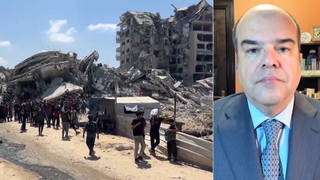
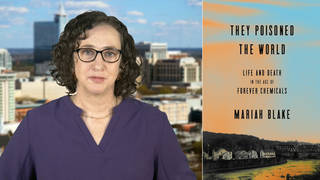

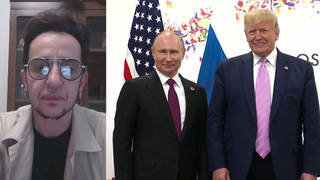

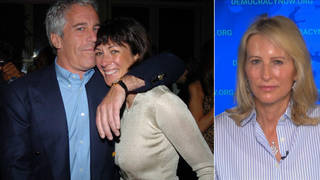
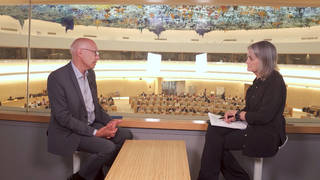
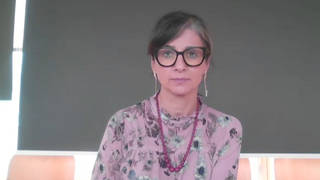



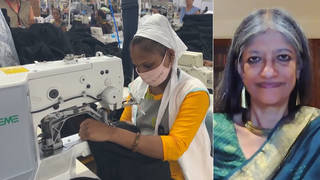
Media Options